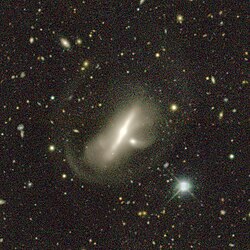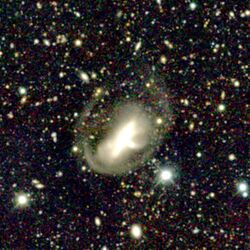Astronomy:NGC 322
From HandWiki
Short description: Lenticular galaxy in the constellation Phoenix
| NGC 322 | |
|---|---|
 DECam view of NGC 322 | |
| Observation data (J2000 epoch) | |
| Constellation | Phoenix |
| Right ascension | 00h 57m 10.0s[1] |
| Declination | −43° 43′ 37″[1] |
| Redshift | 0.023770[1] |
| Helio radial velocity | 7,126 km/s[1] |
| Distance | 318 Mly[2] |
| Apparent magnitude (V) | 14.25[1] |
| Characteristics | |
| Type | S0[1] |
| Apparent size (V) | 1.1' × 0.6'[1] |
| Other designations | |
| ESO 243- G 015, MCG -07-03-003, 2MASX J00570999-4343376, ESO-LV 2430150, 6dF J0057100-434338, PGC 3412.[1] | |
NGC 322 is a lenticular galaxy located approximately 318 million light-years from the Solar System[2] in the constellation Phoenix. It was discovered on September 5, 1834 by John Herschel. It was described by Dreyer as "very faint, very small, round, a little brighter middle, 3 stars to west." It apparently seems to be interacting with PGC 95427, another galaxy.[3]
One supernova, SN 2018bwv (type Ia, mag. 16.2), was discovered in NGC 322 on 23 May, 2018.[4]
From legacy survey images a faint ring or tidal feature can be seen around NGC 322.[5]

See also
References
- ↑ 1.0 1.1 1.2 1.3 1.4 1.5 1.6 1.7 "NASA/IPAC Extragalactic Database". Results for NGC 0322. http://ned.ipac.caltech.edu/cgi-bin/objsearch?objname=NGC+322&extend=no&hconst=73&omegam=0.27&omegav=0.73&corr_z=1&out_csys=Equatorial&out_equinox=J2000.0&obj_sort=RA+or+Longitude&of=pre_text&zv_breaker=30000.0&list_limit=5&img_stamp=YES.
- ↑ 2.0 2.1 An object's distance from Earth can be determined using Hubble's law: v=Ho is Hubble's constant (70±5 (km/s)/Mpc). The relative uncertainty Δd/d divided by the distance is equal to the sum of the relative uncertainties of the velocity and v=Ho
- ↑ "New General Catalog Objects: NGC 300 - 349". Cseligman. http://cseligman.com/text/atlas/ngc3.htm#322.
- ↑ Transient Name Server entry for SN 2018bwv. Retrieved 24 March 2023.
- ↑ "Legacy Survey Sky Browser". https://www.legacysurvey.org/viewer?ra=14.2950&dec=-43.7237&layer=ls-dr9&zoom=13. "Using a contrast of 1.2 to 1.3 and a high brightness of 5 makes these features appear."
External links
- NGC 322 on WikiSky: DSS2, SDSS, GALEX, IRAS, Hydrogen α, X-Ray, Astrophoto, Sky Map, Articles and images
- SEDS
Coordinates: ![]() 00h 57m 10.0s, -43° 43′ 37″
00h 57m 10.0s, -43° 43′ 37″
 |

